Employee Motivation and Factors Influencing the World of Work
VerifiedAdded on 2022/12/09
|8
|2070
|225
Report
AI Summary
This report delves into the multifaceted aspects of employee motivation within the context of a workplace, specifically focusing on IOM electronics. The report begins by identifying several key factors that drive employees, including recognition, sense of purpose, positive work culture, opportunities for learning and development, career advancements, social needs, and compensation. It further examines both positive and negative experiences employees encounter, such as efficiency and effectiveness, positive work culture, and employee retention, as well as conflicts, lack of productivity, absenteeism, and poor management. The report concludes by emphasizing the importance of these motivational factors for attracting and retaining a talented workforce, ultimately impacting the success of the organization. The report utilizes various references to support the findings and provide a comprehensive overview of the subject matter.

World of Work
Paraphrase This Document
Need a fresh take? Get an instant paraphrase of this document with our AI Paraphraser
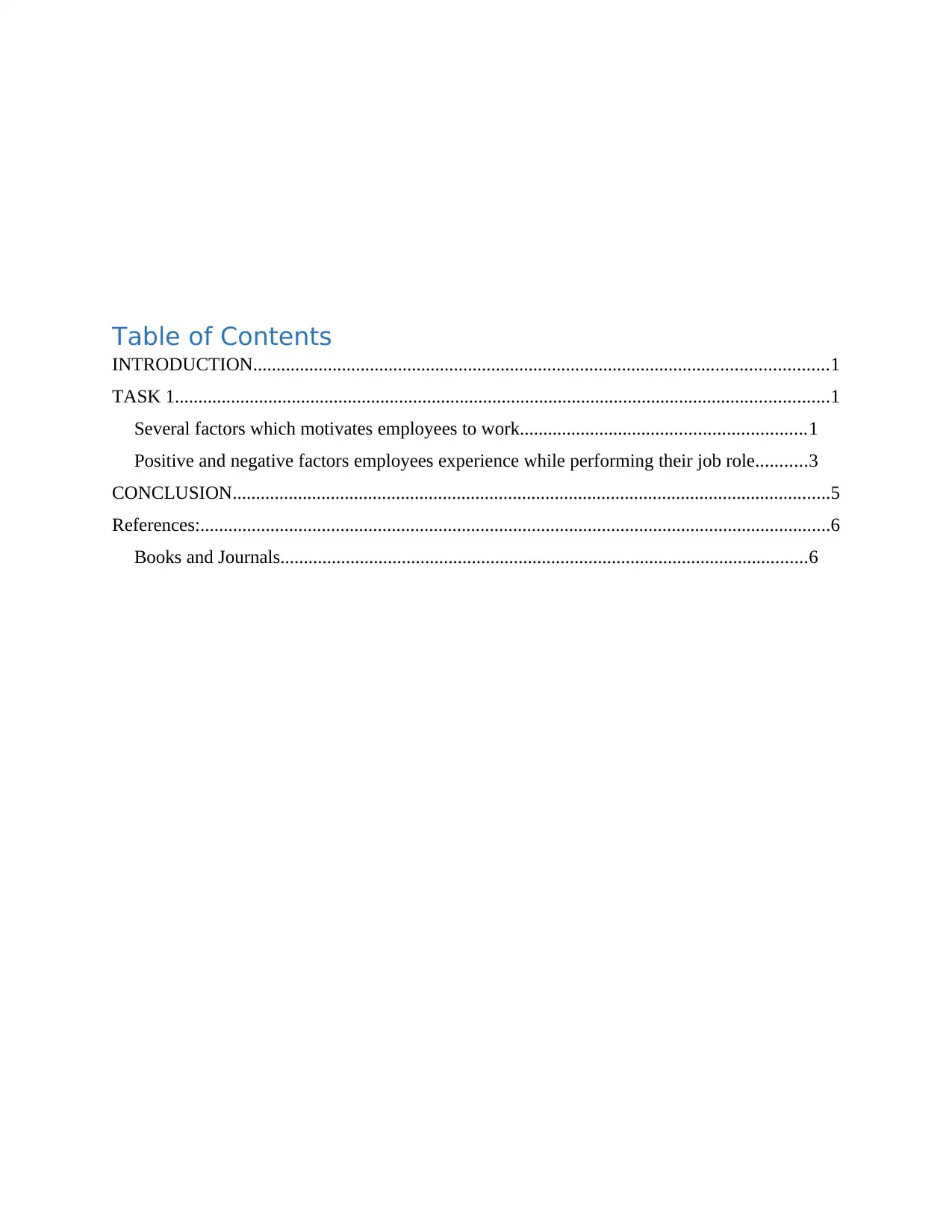
Table of Contents
INTRODUCTION...........................................................................................................................1
TASK 1............................................................................................................................................1
Several factors which motivates employees to work.............................................................1
Positive and negative factors employees experience while performing their job role...........3
CONCLUSION................................................................................................................................5
References:.......................................................................................................................................6
Books and Journals.................................................................................................................6
INTRODUCTION...........................................................................................................................1
TASK 1............................................................................................................................................1
Several factors which motivates employees to work.............................................................1
Positive and negative factors employees experience while performing their job role...........3
CONCLUSION................................................................................................................................5
References:.......................................................................................................................................6
Books and Journals.................................................................................................................6
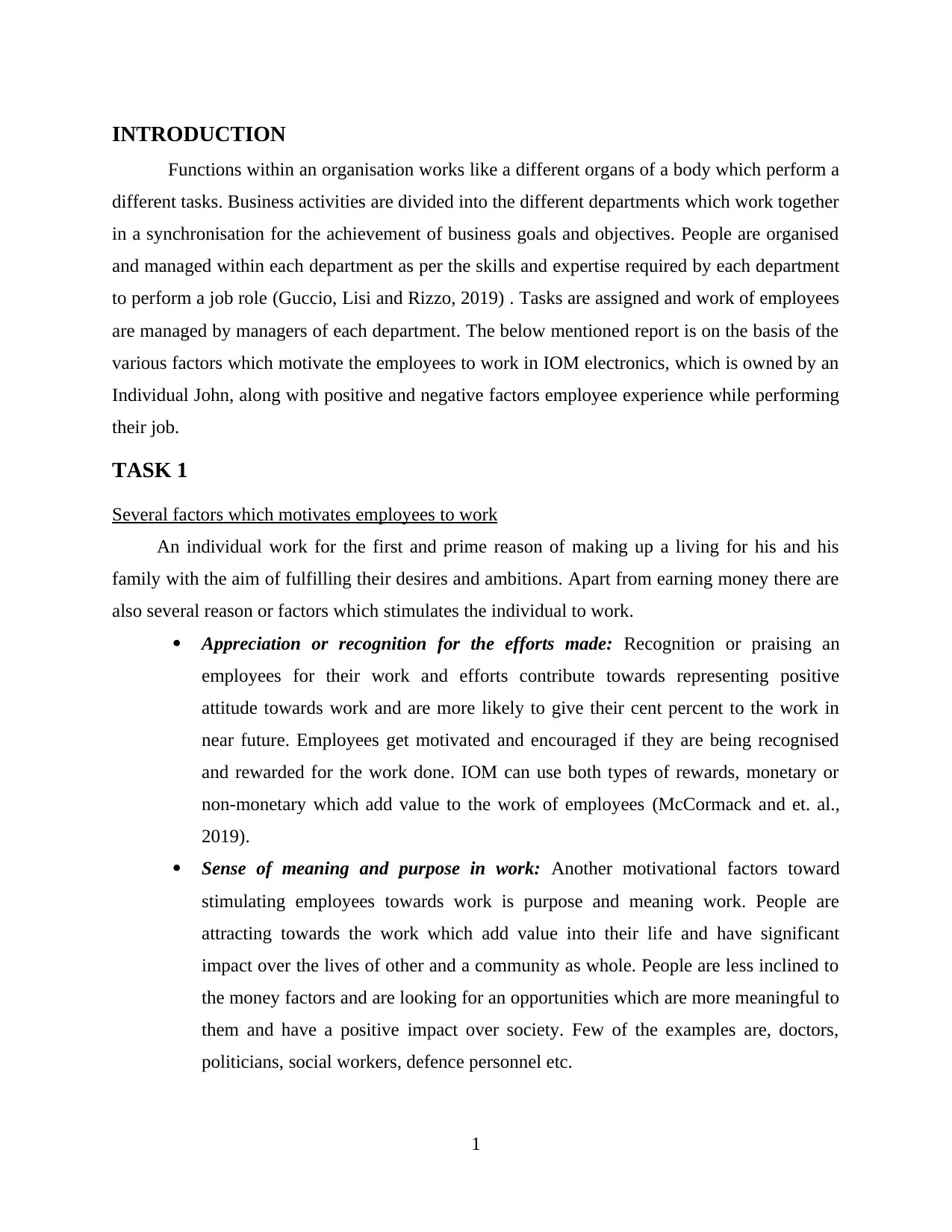
INTRODUCTION
Functions within an organisation works like a different organs of a body which perform a
different tasks. Business activities are divided into the different departments which work together
in a synchronisation for the achievement of business goals and objectives. People are organised
and managed within each department as per the skills and expertise required by each department
to perform a job role (Guccio, Lisi and Rizzo, 2019) . Tasks are assigned and work of employees
are managed by managers of each department. The below mentioned report is on the basis of the
various factors which motivate the employees to work in IOM electronics, which is owned by an
Individual John, along with positive and negative factors employee experience while performing
their job.
TASK 1
Several factors which motivates employees to work
An individual work for the first and prime reason of making up a living for his and his
family with the aim of fulfilling their desires and ambitions. Apart from earning money there are
also several reason or factors which stimulates the individual to work.
Appreciation or recognition for the efforts made: Recognition or praising an
employees for their work and efforts contribute towards representing positive
attitude towards work and are more likely to give their cent percent to the work in
near future. Employees get motivated and encouraged if they are being recognised
and rewarded for the work done. IOM can use both types of rewards, monetary or
non-monetary which add value to the work of employees (McCormack and et. al.,
2019).
Sense of meaning and purpose in work: Another motivational factors toward
stimulating employees towards work is purpose and meaning work. People are
attracting towards the work which add value into their life and have significant
impact over the lives of other and a community as whole. People are less inclined to
the money factors and are looking for an opportunities which are more meaningful to
them and have a positive impact over society. Few of the examples are, doctors,
politicians, social workers, defence personnel etc.
1
Functions within an organisation works like a different organs of a body which perform a
different tasks. Business activities are divided into the different departments which work together
in a synchronisation for the achievement of business goals and objectives. People are organised
and managed within each department as per the skills and expertise required by each department
to perform a job role (Guccio, Lisi and Rizzo, 2019) . Tasks are assigned and work of employees
are managed by managers of each department. The below mentioned report is on the basis of the
various factors which motivate the employees to work in IOM electronics, which is owned by an
Individual John, along with positive and negative factors employee experience while performing
their job.
TASK 1
Several factors which motivates employees to work
An individual work for the first and prime reason of making up a living for his and his
family with the aim of fulfilling their desires and ambitions. Apart from earning money there are
also several reason or factors which stimulates the individual to work.
Appreciation or recognition for the efforts made: Recognition or praising an
employees for their work and efforts contribute towards representing positive
attitude towards work and are more likely to give their cent percent to the work in
near future. Employees get motivated and encouraged if they are being recognised
and rewarded for the work done. IOM can use both types of rewards, monetary or
non-monetary which add value to the work of employees (McCormack and et. al.,
2019).
Sense of meaning and purpose in work: Another motivational factors toward
stimulating employees towards work is purpose and meaning work. People are
attracting towards the work which add value into their life and have significant
impact over the lives of other and a community as whole. People are less inclined to
the money factors and are looking for an opportunities which are more meaningful to
them and have a positive impact over society. Few of the examples are, doctors,
politicians, social workers, defence personnel etc.
1
⊘ This is a preview!⊘
Do you want full access?
Subscribe today to unlock all pages.

Trusted by 1+ million students worldwide
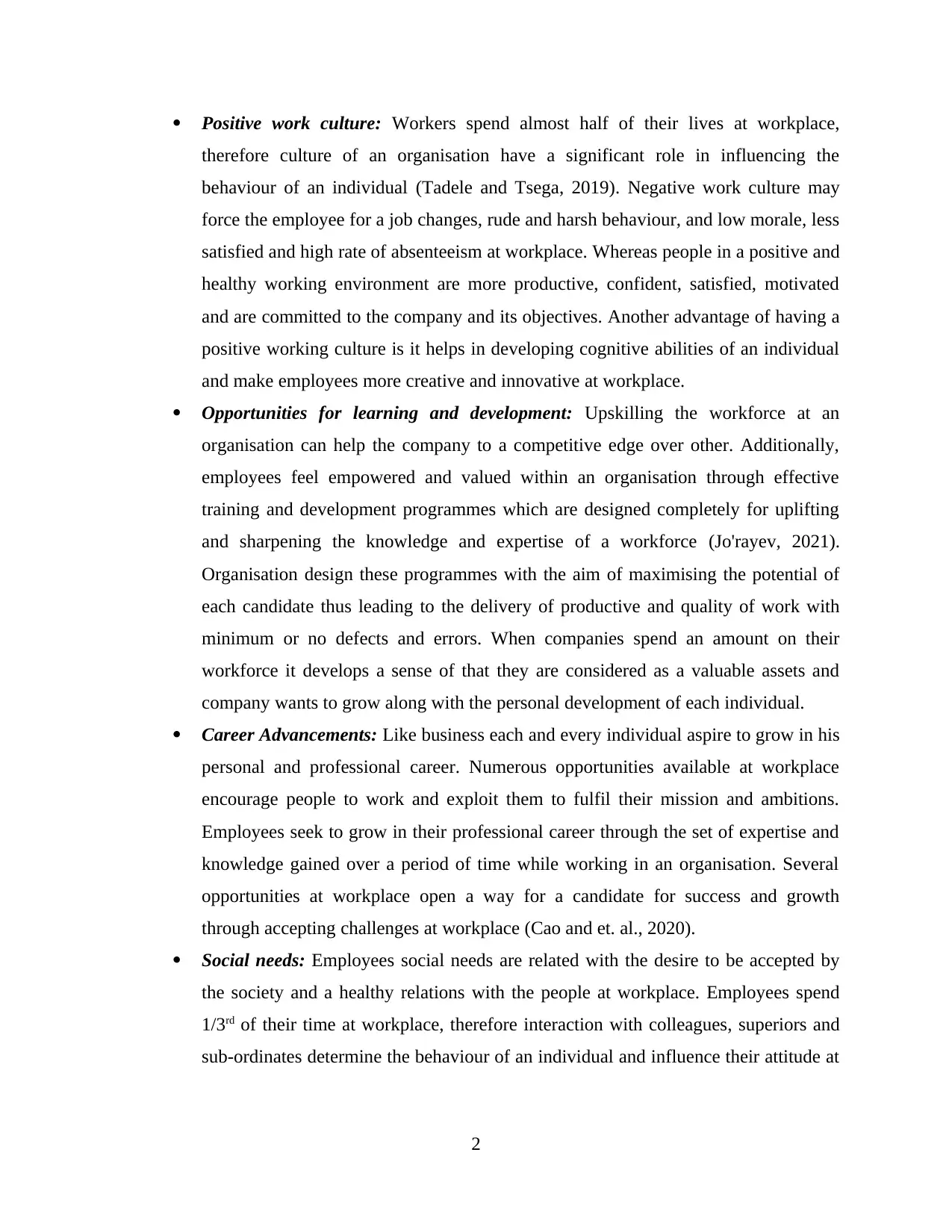
Positive work culture: Workers spend almost half of their lives at workplace,
therefore culture of an organisation have a significant role in influencing the
behaviour of an individual (Tadele and Tsega, 2019). Negative work culture may
force the employee for a job changes, rude and harsh behaviour, and low morale, less
satisfied and high rate of absenteeism at workplace. Whereas people in a positive and
healthy working environment are more productive, confident, satisfied, motivated
and are committed to the company and its objectives. Another advantage of having a
positive working culture is it helps in developing cognitive abilities of an individual
and make employees more creative and innovative at workplace.
Opportunities for learning and development: Upskilling the workforce at an
organisation can help the company to a competitive edge over other. Additionally,
employees feel empowered and valued within an organisation through effective
training and development programmes which are designed completely for uplifting
and sharpening the knowledge and expertise of a workforce (Jo'rayev, 2021).
Organisation design these programmes with the aim of maximising the potential of
each candidate thus leading to the delivery of productive and quality of work with
minimum or no defects and errors. When companies spend an amount on their
workforce it develops a sense of that they are considered as a valuable assets and
company wants to grow along with the personal development of each individual.
Career Advancements: Like business each and every individual aspire to grow in his
personal and professional career. Numerous opportunities available at workplace
encourage people to work and exploit them to fulfil their mission and ambitions.
Employees seek to grow in their professional career through the set of expertise and
knowledge gained over a period of time while working in an organisation. Several
opportunities at workplace open a way for a candidate for success and growth
through accepting challenges at workplace (Cao and et. al., 2020).
Social needs: Employees social needs are related with the desire to be accepted by
the society and a healthy relations with the people at workplace. Employees spend
1/3rd of their time at workplace, therefore interaction with colleagues, superiors and
sub-ordinates determine the behaviour of an individual and influence their attitude at
2
therefore culture of an organisation have a significant role in influencing the
behaviour of an individual (Tadele and Tsega, 2019). Negative work culture may
force the employee for a job changes, rude and harsh behaviour, and low morale, less
satisfied and high rate of absenteeism at workplace. Whereas people in a positive and
healthy working environment are more productive, confident, satisfied, motivated
and are committed to the company and its objectives. Another advantage of having a
positive working culture is it helps in developing cognitive abilities of an individual
and make employees more creative and innovative at workplace.
Opportunities for learning and development: Upskilling the workforce at an
organisation can help the company to a competitive edge over other. Additionally,
employees feel empowered and valued within an organisation through effective
training and development programmes which are designed completely for uplifting
and sharpening the knowledge and expertise of a workforce (Jo'rayev, 2021).
Organisation design these programmes with the aim of maximising the potential of
each candidate thus leading to the delivery of productive and quality of work with
minimum or no defects and errors. When companies spend an amount on their
workforce it develops a sense of that they are considered as a valuable assets and
company wants to grow along with the personal development of each individual.
Career Advancements: Like business each and every individual aspire to grow in his
personal and professional career. Numerous opportunities available at workplace
encourage people to work and exploit them to fulfil their mission and ambitions.
Employees seek to grow in their professional career through the set of expertise and
knowledge gained over a period of time while working in an organisation. Several
opportunities at workplace open a way for a candidate for success and growth
through accepting challenges at workplace (Cao and et. al., 2020).
Social needs: Employees social needs are related with the desire to be accepted by
the society and a healthy relations with the people at workplace. Employees spend
1/3rd of their time at workplace, therefore interaction with colleagues, superiors and
sub-ordinates determine the behaviour of an individual and influence their attitude at
2
Paraphrase This Document
Need a fresh take? Get an instant paraphrase of this document with our AI Paraphraser
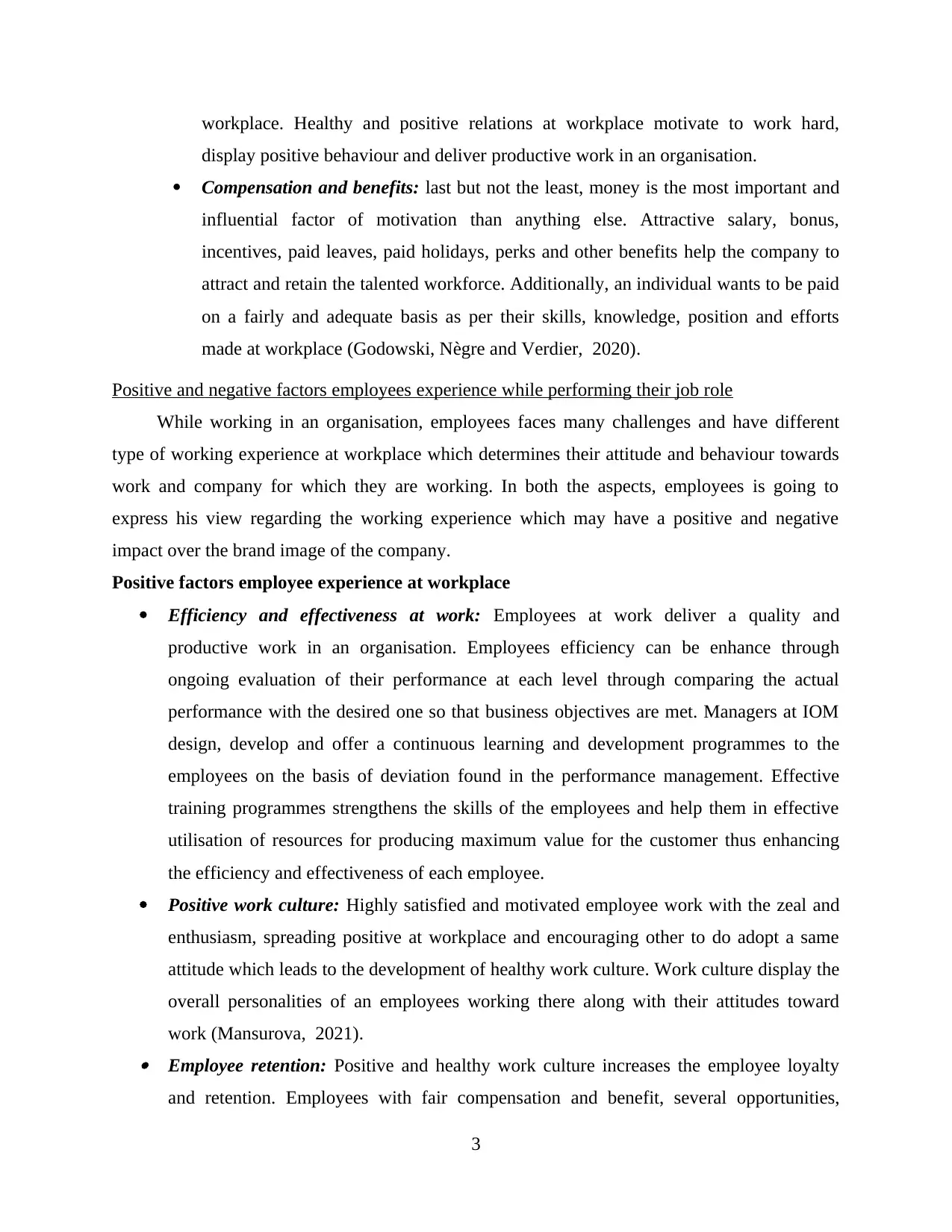
workplace. Healthy and positive relations at workplace motivate to work hard,
display positive behaviour and deliver productive work in an organisation.
Compensation and benefits: last but not the least, money is the most important and
influential factor of motivation than anything else. Attractive salary, bonus,
incentives, paid leaves, paid holidays, perks and other benefits help the company to
attract and retain the talented workforce. Additionally, an individual wants to be paid
on a fairly and adequate basis as per their skills, knowledge, position and efforts
made at workplace (Godowski, Nègre and Verdier, 2020).
Positive and negative factors employees experience while performing their job role
While working in an organisation, employees faces many challenges and have different
type of working experience at workplace which determines their attitude and behaviour towards
work and company for which they are working. In both the aspects, employees is going to
express his view regarding the working experience which may have a positive and negative
impact over the brand image of the company.
Positive factors employee experience at workplace
Efficiency and effectiveness at work: Employees at work deliver a quality and
productive work in an organisation. Employees efficiency can be enhance through
ongoing evaluation of their performance at each level through comparing the actual
performance with the desired one so that business objectives are met. Managers at IOM
design, develop and offer a continuous learning and development programmes to the
employees on the basis of deviation found in the performance management. Effective
training programmes strengthens the skills of the employees and help them in effective
utilisation of resources for producing maximum value for the customer thus enhancing
the efficiency and effectiveness of each employee.
Positive work culture: Highly satisfied and motivated employee work with the zeal and
enthusiasm, spreading positive at workplace and encouraging other to do adopt a same
attitude which leads to the development of healthy work culture. Work culture display the
overall personalities of an employees working there along with their attitudes toward
work (Mansurova, 2021). Employee retention: Positive and healthy work culture increases the employee loyalty
and retention. Employees with fair compensation and benefit, several opportunities,
3
display positive behaviour and deliver productive work in an organisation.
Compensation and benefits: last but not the least, money is the most important and
influential factor of motivation than anything else. Attractive salary, bonus,
incentives, paid leaves, paid holidays, perks and other benefits help the company to
attract and retain the talented workforce. Additionally, an individual wants to be paid
on a fairly and adequate basis as per their skills, knowledge, position and efforts
made at workplace (Godowski, Nègre and Verdier, 2020).
Positive and negative factors employees experience while performing their job role
While working in an organisation, employees faces many challenges and have different
type of working experience at workplace which determines their attitude and behaviour towards
work and company for which they are working. In both the aspects, employees is going to
express his view regarding the working experience which may have a positive and negative
impact over the brand image of the company.
Positive factors employee experience at workplace
Efficiency and effectiveness at work: Employees at work deliver a quality and
productive work in an organisation. Employees efficiency can be enhance through
ongoing evaluation of their performance at each level through comparing the actual
performance with the desired one so that business objectives are met. Managers at IOM
design, develop and offer a continuous learning and development programmes to the
employees on the basis of deviation found in the performance management. Effective
training programmes strengthens the skills of the employees and help them in effective
utilisation of resources for producing maximum value for the customer thus enhancing
the efficiency and effectiveness of each employee.
Positive work culture: Highly satisfied and motivated employee work with the zeal and
enthusiasm, spreading positive at workplace and encouraging other to do adopt a same
attitude which leads to the development of healthy work culture. Work culture display the
overall personalities of an employees working there along with their attitudes toward
work (Mansurova, 2021). Employee retention: Positive and healthy work culture increases the employee loyalty
and retention. Employees with fair compensation and benefit, several opportunities,
3
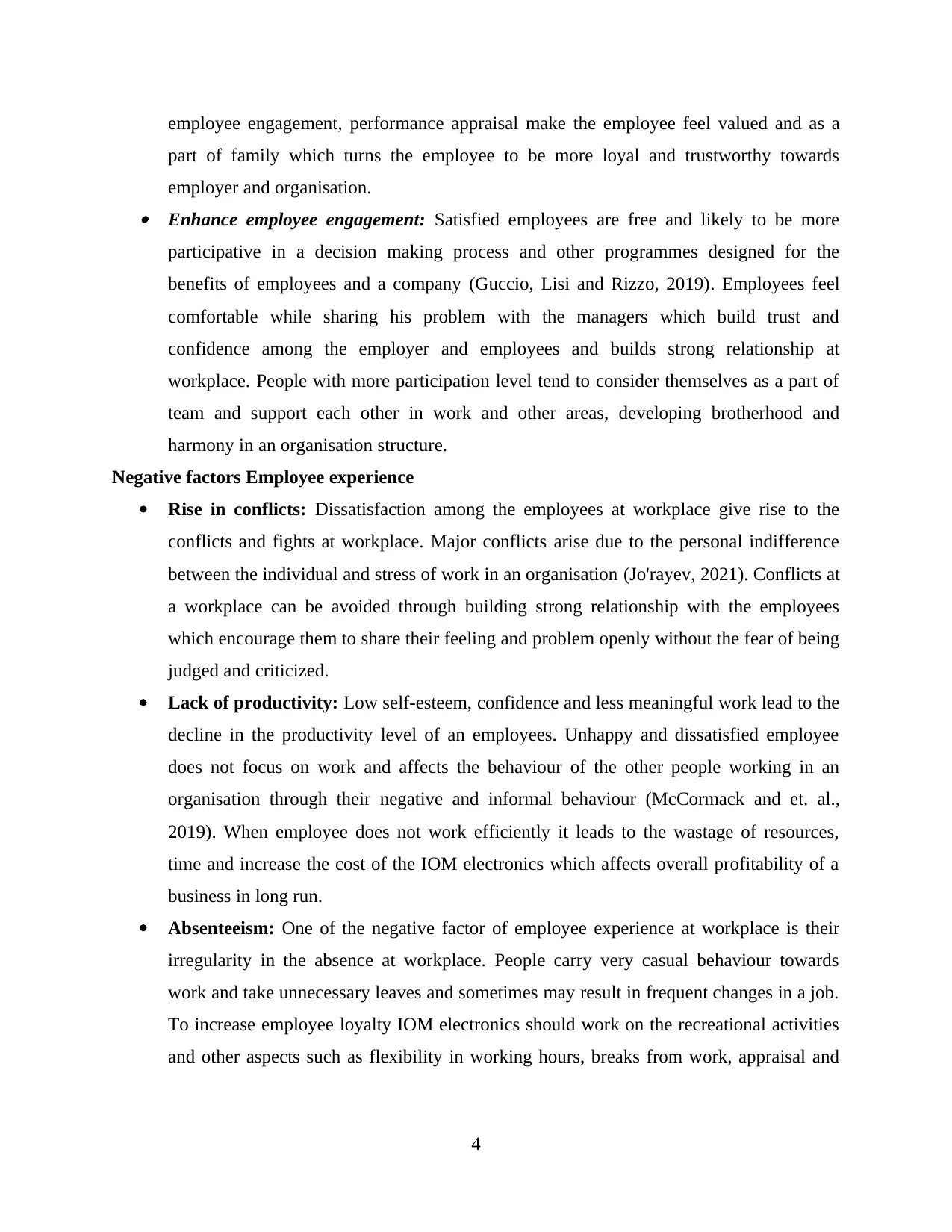
employee engagement, performance appraisal make the employee feel valued and as a
part of family which turns the employee to be more loyal and trustworthy towards
employer and organisation. Enhance employee engagement: Satisfied employees are free and likely to be more
participative in a decision making process and other programmes designed for the
benefits of employees and a company (Guccio, Lisi and Rizzo, 2019). Employees feel
comfortable while sharing his problem with the managers which build trust and
confidence among the employer and employees and builds strong relationship at
workplace. People with more participation level tend to consider themselves as a part of
team and support each other in work and other areas, developing brotherhood and
harmony in an organisation structure.
Negative factors Employee experience
Rise in conflicts: Dissatisfaction among the employees at workplace give rise to the
conflicts and fights at workplace. Major conflicts arise due to the personal indifference
between the individual and stress of work in an organisation (Jo'rayev, 2021). Conflicts at
a workplace can be avoided through building strong relationship with the employees
which encourage them to share their feeling and problem openly without the fear of being
judged and criticized.
Lack of productivity: Low self-esteem, confidence and less meaningful work lead to the
decline in the productivity level of an employees. Unhappy and dissatisfied employee
does not focus on work and affects the behaviour of the other people working in an
organisation through their negative and informal behaviour (McCormack and et. al.,
2019). When employee does not work efficiently it leads to the wastage of resources,
time and increase the cost of the IOM electronics which affects overall profitability of a
business in long run.
Absenteeism: One of the negative factor of employee experience at workplace is their
irregularity in the absence at workplace. People carry very casual behaviour towards
work and take unnecessary leaves and sometimes may result in frequent changes in a job.
To increase employee loyalty IOM electronics should work on the recreational activities
and other aspects such as flexibility in working hours, breaks from work, appraisal and
4
part of family which turns the employee to be more loyal and trustworthy towards
employer and organisation. Enhance employee engagement: Satisfied employees are free and likely to be more
participative in a decision making process and other programmes designed for the
benefits of employees and a company (Guccio, Lisi and Rizzo, 2019). Employees feel
comfortable while sharing his problem with the managers which build trust and
confidence among the employer and employees and builds strong relationship at
workplace. People with more participation level tend to consider themselves as a part of
team and support each other in work and other areas, developing brotherhood and
harmony in an organisation structure.
Negative factors Employee experience
Rise in conflicts: Dissatisfaction among the employees at workplace give rise to the
conflicts and fights at workplace. Major conflicts arise due to the personal indifference
between the individual and stress of work in an organisation (Jo'rayev, 2021). Conflicts at
a workplace can be avoided through building strong relationship with the employees
which encourage them to share their feeling and problem openly without the fear of being
judged and criticized.
Lack of productivity: Low self-esteem, confidence and less meaningful work lead to the
decline in the productivity level of an employees. Unhappy and dissatisfied employee
does not focus on work and affects the behaviour of the other people working in an
organisation through their negative and informal behaviour (McCormack and et. al.,
2019). When employee does not work efficiently it leads to the wastage of resources,
time and increase the cost of the IOM electronics which affects overall profitability of a
business in long run.
Absenteeism: One of the negative factor of employee experience at workplace is their
irregularity in the absence at workplace. People carry very casual behaviour towards
work and take unnecessary leaves and sometimes may result in frequent changes in a job.
To increase employee loyalty IOM electronics should work on the recreational activities
and other aspects such as flexibility in working hours, breaks from work, appraisal and
4
⊘ This is a preview!⊘
Do you want full access?
Subscribe today to unlock all pages.

Trusted by 1+ million students worldwide
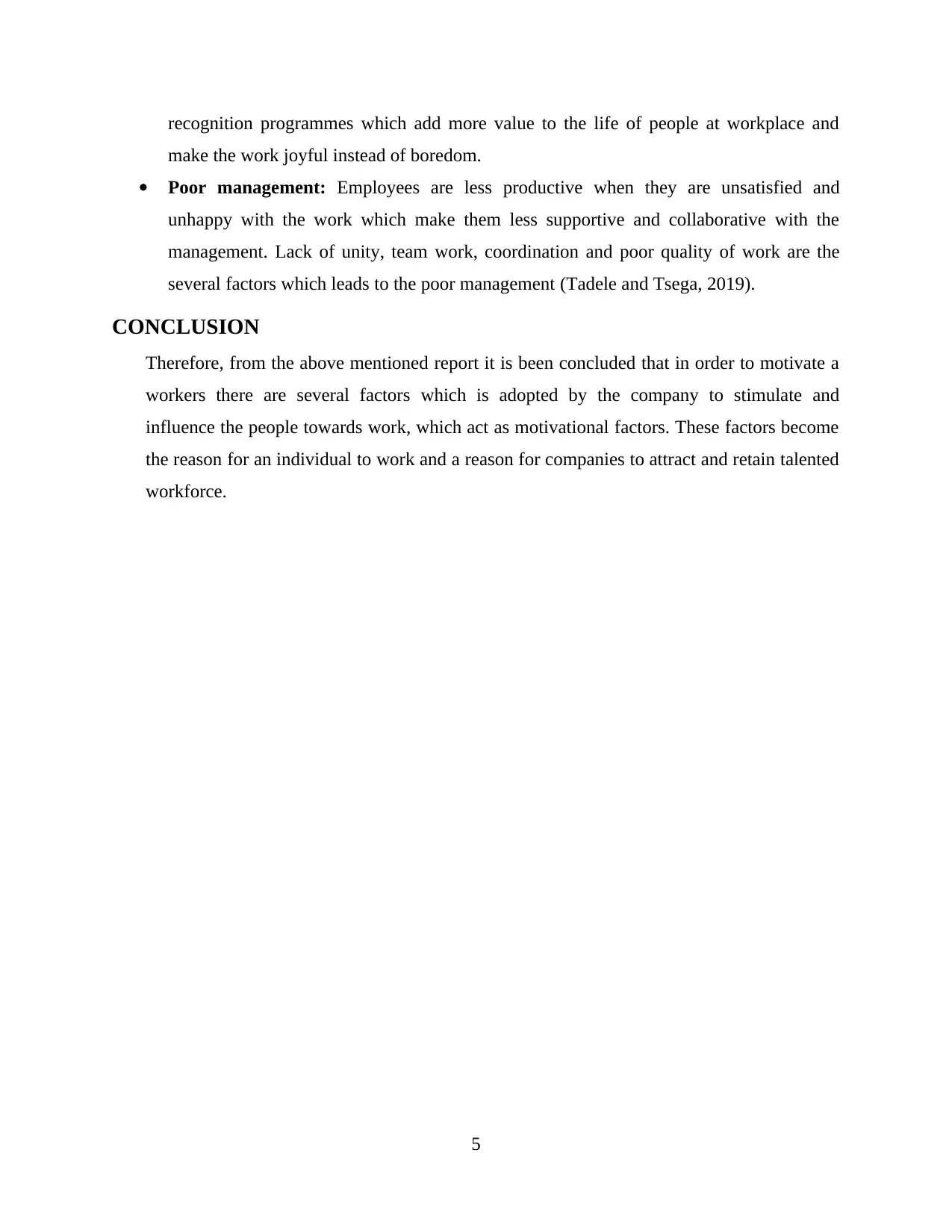
recognition programmes which add more value to the life of people at workplace and
make the work joyful instead of boredom.
Poor management: Employees are less productive when they are unsatisfied and
unhappy with the work which make them less supportive and collaborative with the
management. Lack of unity, team work, coordination and poor quality of work are the
several factors which leads to the poor management (Tadele and Tsega, 2019).
CONCLUSION
Therefore, from the above mentioned report it is been concluded that in order to motivate a
workers there are several factors which is adopted by the company to stimulate and
influence the people towards work, which act as motivational factors. These factors become
the reason for an individual to work and a reason for companies to attract and retain talented
workforce.
5
make the work joyful instead of boredom.
Poor management: Employees are less productive when they are unsatisfied and
unhappy with the work which make them less supportive and collaborative with the
management. Lack of unity, team work, coordination and poor quality of work are the
several factors which leads to the poor management (Tadele and Tsega, 2019).
CONCLUSION
Therefore, from the above mentioned report it is been concluded that in order to motivate a
workers there are several factors which is adopted by the company to stimulate and
influence the people towards work, which act as motivational factors. These factors become
the reason for an individual to work and a reason for companies to attract and retain talented
workforce.
5
Paraphrase This Document
Need a fresh take? Get an instant paraphrase of this document with our AI Paraphraser
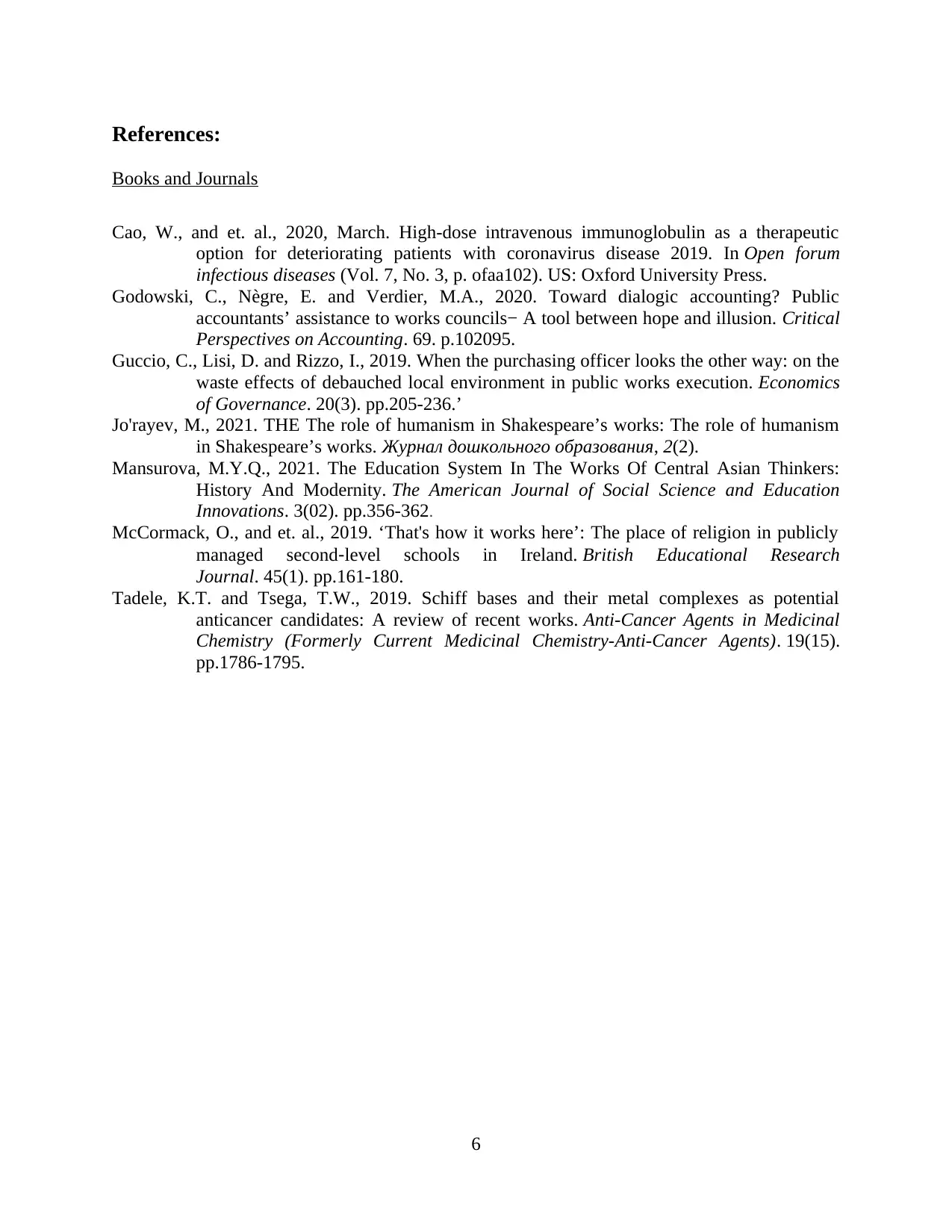
References:
Books and Journals
Cao, W., and et. al., 2020, March. High-dose intravenous immunoglobulin as a therapeutic
option for deteriorating patients with coronavirus disease 2019. In Open forum
infectious diseases (Vol. 7, No. 3, p. ofaa102). US: Oxford University Press.
Godowski, C., Nègre, E. and Verdier, M.A., 2020. Toward dialogic accounting? Public
accountants’ assistance to works councils− A tool between hope and illusion. Critical
Perspectives on Accounting. 69. p.102095.
Guccio, C., Lisi, D. and Rizzo, I., 2019. When the purchasing officer looks the other way: on the
waste effects of debauched local environment in public works execution. Economics
of Governance. 20(3). pp.205-236.’
Jo'rayev, M., 2021. THE The role of humanism in Shakespeare’s works: The role of humanism
in Shakespeare’s works. Журнал дошкольного образования, 2(2).
Mansurova, M.Y.Q., 2021. The Education System In The Works Of Central Asian Thinkers:
History And Modernity. The American Journal of Social Science and Education
Innovations. 3(02). pp.356-362.
McCormack, O., and et. al., 2019. ‘That's how it works here’: The place of religion in publicly
managed second‐level schools in Ireland. British Educational Research
Journal. 45(1). pp.161-180.
Tadele, K.T. and Tsega, T.W., 2019. Schiff bases and their metal complexes as potential
anticancer candidates: A review of recent works. Anti-Cancer Agents in Medicinal
Chemistry (Formerly Current Medicinal Chemistry-Anti-Cancer Agents). 19(15).
pp.1786-1795.
6
Books and Journals
Cao, W., and et. al., 2020, March. High-dose intravenous immunoglobulin as a therapeutic
option for deteriorating patients with coronavirus disease 2019. In Open forum
infectious diseases (Vol. 7, No. 3, p. ofaa102). US: Oxford University Press.
Godowski, C., Nègre, E. and Verdier, M.A., 2020. Toward dialogic accounting? Public
accountants’ assistance to works councils− A tool between hope and illusion. Critical
Perspectives on Accounting. 69. p.102095.
Guccio, C., Lisi, D. and Rizzo, I., 2019. When the purchasing officer looks the other way: on the
waste effects of debauched local environment in public works execution. Economics
of Governance. 20(3). pp.205-236.’
Jo'rayev, M., 2021. THE The role of humanism in Shakespeare’s works: The role of humanism
in Shakespeare’s works. Журнал дошкольного образования, 2(2).
Mansurova, M.Y.Q., 2021. The Education System In The Works Of Central Asian Thinkers:
History And Modernity. The American Journal of Social Science and Education
Innovations. 3(02). pp.356-362.
McCormack, O., and et. al., 2019. ‘That's how it works here’: The place of religion in publicly
managed second‐level schools in Ireland. British Educational Research
Journal. 45(1). pp.161-180.
Tadele, K.T. and Tsega, T.W., 2019. Schiff bases and their metal complexes as potential
anticancer candidates: A review of recent works. Anti-Cancer Agents in Medicinal
Chemistry (Formerly Current Medicinal Chemistry-Anti-Cancer Agents). 19(15).
pp.1786-1795.
6
1 out of 8
Related Documents
Your All-in-One AI-Powered Toolkit for Academic Success.
+13062052269
info@desklib.com
Available 24*7 on WhatsApp / Email
![[object Object]](/_next/static/media/star-bottom.7253800d.svg)
Unlock your academic potential
Copyright © 2020–2025 A2Z Services. All Rights Reserved. Developed and managed by ZUCOL.



